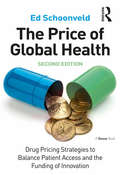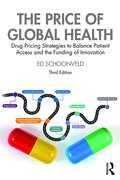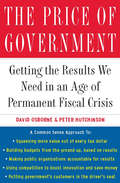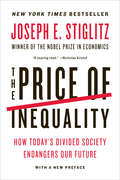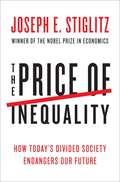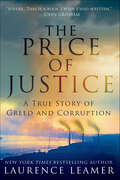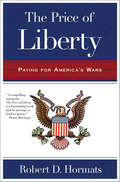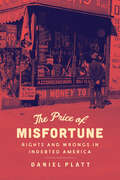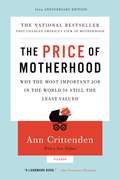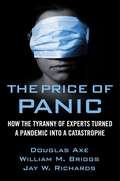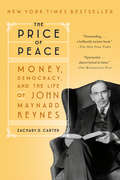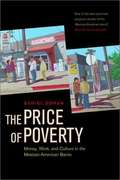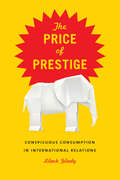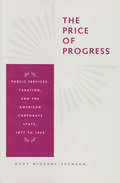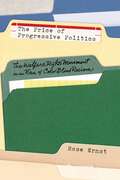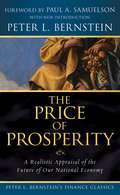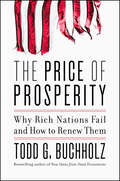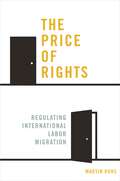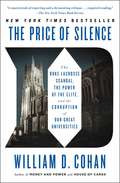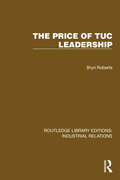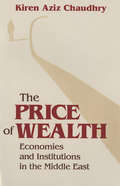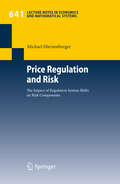- Table View
- List View
The Price of Global Health: Drug Pricing Strategies to Balance Patient Access and the Funding of Innovation
by Ed SchoonveldPublic debate on the rising cost of new biotechnology drug treatments has intensified over the last few years as healthcare budget pressures have mounted under a strained economy. Meanwhile, the demand for new, effective medical and drug treatments continues to rise as unhealthy lifestyles cause further increases in diabetes and cardiovascular disease. Global drug pricing is one of the most hotly debated yet least understood aspects of the pharmaceutical industry. How should drug prices be set and what does it mean for patients? Why do governments increasingly get involved, and what is its impact on the global competitive environment? How can a life-saving industry have a poorer image than gun and tobacco industries, whose products are associated with death? Ed Schoonveld explains how pharmaceutical prices are determined in a complex global payer environment and what factors influence the process. His insights will help a wide range of audiences, from healthcare industry professionals to policy makers and the broader public, to gain a better understanding of this highly complex and emotionally charged field. The Price of Global Health is recognized as a valued and unique reference book that covers a complete array of topics related to global pharmaceutical pricing. It contains an in-depth but straightforward exploration of the pharmaceutical pricing strategy process, its underlying market access, general business and ethical considerations, and its implications for payers, physicians and patients. It is a much-needed and invaluable resource for anybody interested or involved in, or affected by, the development, funding and use of prescription drugs. In particular, it is of critical importance to pharmaceutical company executives and other leaders and professionals in commercialization and drug development, including marketing, business development, market access and pricing, clinical development, drug discovery, regulatory affairs, health outcomes, market research and public affairs. The second edition includes new chapters on payer value story development, oncology, orphan drugs and payer negotiations. Furthermore, many country chapters have been substantially updated to reflect changes in the healthcare systems, including the Affordable Care Act in the US, AMNOG in Germany, medico-economic requirements in France and many other country-specific changes. Lastly, almost every chapter has been updated with new examples and illustrations.
The Price of Global Health: Drug Pricing Strategies to Balance Patient Access and the Funding of Innovation
by Ed SchoonveldThe Price of Global Health is a unique book that describes the pharmaceutical pricing process and its business, economic and social challenges. Global drug pricing is one of the most hotly debated yet least understood aspects of the pharmaceutical industry. How should drug prices be set and what does it mean for patients? Why do governments increasingly get involved, and what is its impact on the global competitive environment? How can a life-saving industry have a poorer image than gun and tobacco industries, whose products are associated with death? The pharmaceutical industry is under unprecedented pressure due to a combination of declining R&D productivity, payer/provider demands for better value and public pressures to show pricing restraint. Rapidly increasing cost of healthcare, shifts from fee-for-service to value-based reimbursement, public pressure on drug pricing and an increasingly vocal medical community have empowered public and private payers worldwide to be more demanding on evidence of value for the prescription drugs that are brought to market. Pharmaceutical companies have often failed to deliver evidence of patient value, as development decision-making is overly focused on speed to FDA approval rather than speed to commercial success by effectively addressing the many “Access Journey” obstacles that typify today’s much changed pharmaceutical environment. This 3rd edition is significantly expanded with ten new chapters and revised and updated throughout to reflect today’s environment. The contents are reorganized to directly address critical pricing and patient access issues. Ed Schoonveld explains how pharmaceutical prices are determined in a complex global payer environment and what factors influence the process. His insights will help a wide range of audiences from healthcare industry professionals to policy makers, consumers, pharmaceutical company leaders and access and pricing professionals to gain a better understanding of this highly complex and emotionally charged field.
The Price of Government: Getting the Results We Need in an Age of Permanent Fiscal Crisis
by David Osborne Peter HutchinsonThe authors (both of the Public Strategies Group) present their solution to the U. S. fiscal crisis to a general readership. Citing Washington Governor Locke's approach to the 2002/2003 state budget as an exemplar, they describe a process of setting a budget priorities and matching it to available funds. They also present 10 approaches to increasing the value of dollars spent, including consolidating funding streams, strategic divestment reviews, buying services competitively, setting and rewarding performance targets, and finding "smarter" work processes. Annotation ©2004 Book News, Inc. , Portland, OR (booknews. com)
The Price of Inequality: How Today's Divided Society Endangers Our Future
by Joseph E. StiglitzA forceful argument against America's vicious circle of growing inequality by the Nobel Prize-winning economist. America currently has the most inequality, and the least equality of opportunity, among the advanced countries. While market forces play a role in this stark picture, politics has shaped those market forces. In this best-selling book, Nobel Prize-winning economist Joseph E. Stiglitz exposes the efforts of well-heeled interests to compound their wealth in ways that have stifled true, dynamic capitalism. Along the way he examines the effect of inequality on our economy, our democracy, and our system of justice. Stiglitz explains how inequality affects and is affected by every aspect of national policy, and with characteristic insight he offers a vision for a more just and prosperous future, supported by a concrete program to achieve that vision.
The Price of Inequality: How Today's Divided Society Endangers Our Future
by Joseph E. StiglitzThe top 1 percent of Americans control 40 percent of the nation's wealth. And, as Joseph E. Stiglitz explains, while those at the top enjoy the best health care, education, and benefits of wealth, they fail to realize that "their fate is bound up with how the other 99 percent live." Stiglitz draws on his deep understanding of economics to show that growing inequality is not inevitable: moneyed interests compound their wealth by stifling true, dynamic capitalism. They have made America the most unequal advanced industrial country while crippling growth, trampling on the rule of law, and undermining democracy. The result: a divided society that cannot tackle its most pressing problems. With characteristic insight, Stiglitz examines our current state, then teases out its implications for democracy, for monetary and budgetary policy, and for globalization. He closes with a plan for a more just and prosperous future.
The Price of Justice: A True Story of Greed and Corruption
by Laurence LeamerA nonfiction legal thriller that traces the fourteen-year struggle of two lawyers to bring the most powerful coal baron in American history, Don Blankenship, to justiceDon Blankenship, head of Massey Energy since the early 1990s, ran an industry that provides nearly half of America's electric power. But wealth and influence weren't enough for Blankenship and his company, as they set about destroying corporate and personal rivals, challenging the Constitution, purchasing the West Virginia judiciary, and willfully disregarding safety standards in the company's mines—in which scores died unnecessarily.As Blankenship hobnobbed with a West Virginia Supreme Court justice in France, his company polluted the drinking water of hundreds of citizens while he himself fostered baroque vendettas against anyone who dared challenge his sovereignty over coal mining country. Just about the only thing that stood in the way of Blankenship's tyranny over a state and an industry was a pair of odd-couple attorneys, Dave Fawcett and Bruce Stanley, who undertook a legal quest to bring justice to this corner of America. From the backwoods courtrooms of West Virginia they pursued their case all the way to the U.S. Supreme Court, and to a dramatic decision declaring that the wealthy and powerful are not entitled to purchase their own brand of law.The Price of Justice is a story of corporate corruption so far-reaching and devastating it could have been written a hundred years ago by Ida Tarbell or Lincoln Steffens. And as Laurence Leamer demonstrates in this captivating tale, because it's true, it's scarier than fiction.
The Price of Liberty: Paying for America's Wars
by Robert D. HormatsIn a bracing work of history, a leading international finance expert reveals how our national security depends on our financial securityMore than two centuries ago, America's first secretary of the treasury, Alexander Hamilton, identified the Revolutionary War debt as a threat to the nation's creditworthiness and its very existence. In response, he established financial principles for securing the country—principles that endure to this day. In this provocative history, Robert D. Hormats, one of America's leading experts on international finance, shows how leaders from Madison and Lincoln to FDR and Reagan have followed Hamilton's ideals, from the greenback and a progressive income tax to the Victory Bond and Victory Garden campaigns and cost-sharing with allies. Drawing on these historical lessons, Hormats argues that the rampant borrowing to pay for the war in Iraq and the short-sighted tax cuts in the face of a long-term war on terrorism run counter to American tradition and place our country's security in peril. To meet the threats facing us, Hormats contends, we must significantly realign our economic policies—on taxes, Social Security, Medicare, and oil dependency—to safeguard our liberty and our future.
The Price of Life and the Cost of Health Care: Why the Free Market Alone Can't Fix Health Care
by Peter A. UbelHealth-care expenses have been rising faster than inflation in virtually every industrialized country for the past several decades, making it increasingly difficult for people to afford health care. Market advocates like George W. Bush argue that the solution resides in the power of markets. If health-care markets were more competitive, the thinking goes, then health-care quality would increase at the same time that health-care prices go down. However, what this theory doesn't take into account is the fact that when people evaluate health-care interventions, they often rely on psychological shortcuts that impede good decision making. This chapter examines how factors like scarcity, novelty, and price influence people's perceptions of the quality of goods they purchase, challenging the idea that free markets are the solution to the inefficiencies of the health-care system and other widespread problems. This chapter is excerpted from "Free Market Madness: Why Human Nature Is at Odds with Economics--and Why It Matters."
The Price of Misfortune: Rights and Wrongs in Indebted America
by Daniel PlattA history of the struggle for debtors’ rights from the Civil War to the Great Depression What can be taken from someone who has borrowed money and cannot repay? What do the victims of misfortune owe to their lenders, and what can they keep for themselves? The answers to those questions, immensely important for debtors, creditors, and society at large, have changed over time. The Price of Misfortune examines the cause of debtors’ rights in the modern United States and the struggles of reformers who fought to establish financial freedoms in law. Daniel Platt shows how, in the wake of the Civil War, a range of advocates drew potent analogies between slavery, imprisonment for debt, and the experiences of wage garnishment and property foreclosure. He traces the ways those analogies were used to campaign for bold new protections for debtors, keeping them secure in their labor, property, and personhood. Yet, as Platt demonstrates, those reforms tended to assume as their ideal borrower someone who was white, propertied, and male. In subsequent decades, the emancipatory promise of debtors’ rights would be tested as women, wage earners, and African Americans seized on their language to challenge other structural inequalities: the dependency of marriage, the exploitation of industrial capitalism, and the oppression of Jim Crow. By reconstructing these forgotten developments—and recovering the experiences of indebted farmwives, sharecroppers, and wage workers—The Price of Misfortune narrates a new history of inequality, coercion, and law amid the early financialization of American capitalism.
The Price of Motherhood: Why the Most Important Job in the World Is Still the Least Valued
by Ann CrittendenTHE 10TH ANNIVERSARY EDITION OF THE NATIONAL BESTSELLER THAT CHANGED AMERICA'S VIEW OF MOTHERHOOD In the pathbreaking tradition of Backlash and The Second Shift, this provocative book shows how mothers are systematically disadvantaged and made dependent by a society that exploits those who perform its most critical work. Drawing on hundreds of interviews and research in economics, history, child development, and law, Ann Crittenden proves definitively that although women have been liberated, mothers have not. Bold, galvanizing, and full of innovative solutions, The Price of Motherhood was listed by the Chicago Tribune as one of the Top Ten Feminist Literary Works since the publication of Betty Friedan's Feminine Mystique. This "bracing call to arms" (Elle) offers a much-needed accounting of the price that mothers pay for performing the most important job in the world.
The Price of Panic: How the Tyranny of Experts Turned a Pandemic into a Catastrophe
by Jay W. Richards William M. Briggs Douglas AxeFor the first time in history, the world shut itself down—by choice—all for fear of a virus, COVID-19, that wasn&’t well understood. The government, with the support of most Americans, ordered the closure of tens of thousands of small businesses—many never to return. Almost every school and college in the country sent its students home to finish the school year in front of a computer. Churches cancelled worship services. &“Social distancing&” went from a non-word to a moral obligation overnight. Moral preening on social media achieved ever new heights. The world will reopen and life will go on, but what kind of world will it be when it does? It can&’t be what it was, because of what&’s just happened. Professors Jay Richards, William Briggs, and Douglas Axe take a deep dive into the crucial questions on the minds of millions of Americans during one of the most jarring and unprecedented global events in a generation. What will be the total cost in dollars, lives, and livelihoods of this response from governments, on advice from Science? What role have national and global health organizations such as WHO played in this? To whom are they accountable? What evidence do they rely on in sounding the alarm? How did science bureaucrats, relying on murky data and speculative computer models, gain the power to shut down the global economy? How did politicians, who know nothing of the science, decide whom to trust? We need to know what and how it happened, to keep it from ever happening again.
The Price of Peace: Money, Democracy, and the Life of John Maynard Keynes
by Zachary D. Carter&“An important, resonant, and memorable portrait&” (Jon Meacham) of world-changing economist John Maynard Keynes and the transformative ideas that outlived him &“A brilliantly wrought, beautifully written life of one of the most captivating intellects of the twentieth century.&”—Liaquat Ahamed, author of Lords of Finance At the dawn of World War I, a young academic named John Maynard Keynes hastily folded his long legs into the sidecar of his brother-in-law&’s motorcycle for an odd, frantic journey that would change the course of history. Swept away from his placid home at Cambridge University by the currents of the conflict, Keynes found himself thrust into the halls of European treasuries to arrange emergency loans and packed off to America to negotiate the terms of economic combat. The terror and anxiety unleashed by the war would transform him from a comfortable obscurity into the most influential and controversial intellectual of his day—a man whose ideas still retain the power to shock in our own time.Keynes was not only an economist but the preeminent anti-authoritarian thinker of the twentieth century, one who devoted his life to the belief that art and ideas could conquer war and deprivation. As a moral philosopher, political theorist, and statesman, Keynes led an extraordinary life that took him from intimate turn-of-the-century parties in London&’s riotous Bloomsbury art scene to the fevered negotiations in Paris that shaped the Treaty of Versailles, from stock market crashes on two continents to diplomatic breakthroughs in the mountains of New Hampshire to wartime ballet openings at London&’s extravagant Covent Garden. Along the way, Keynes reinvented Enlightenment liberalism to meet the harrowing crises of the twentieth century. In the United States, his ideas became the foundation of a burgeoning economics profession, but they also became a flash point in the broader political struggle of the Cold War, as Keynesian acolytes faced off against conservatives in an intellectual battle for the future of the country—and the world. Though many Keynesian ideas survived the struggle, much of the project to which he devoted his life was lost. In this riveting biography, veteran journalist Zachary D. Carter unearths the lost legacy of one of history&’s most fascinating minds. The Price of Peace revives a forgotten set of ideas about democracy, money, and the good life with transformative implications for today&’s debates over inequality and the power politics that shape the global order.
The Price of Poverty: Money, Work, and Culture in the Mexican-american Barrio
by Daniel DohanThis book examines the causes and consequences of poverty in contemporary Mexican-American urban neighborhoods using ethnographic descriptions of poor people's everyday lives.
The Price of Prestige: Conspicuous Consumption in International Relations
by Lilach GiladyIf wars are costly and risky to both sides, why do they occur? Why engage in an arms race when it’s clear that increasing one’s own defense expenditures will only trigger a similar reaction by the other side, leaving both countries just as insecure—and considerably poorer? Just as people buy expensive things precisely because they are more expensive, because they offer the possibility of improved social status or prestige, so too do countries, argues Lilach Gilady. In The Price of Prestige, Gilady shows how many seemingly wasteful government expenditures that appear to contradict the laws of demand actually follow the pattern for what are known as Veblen goods, or positional goods for which demand increases alongside price, even when cheaper substitutes are readily available. From flashy space programs to costly weapons systems a country does not need and cannot maintain to foreign aid programs that offer little benefit to recipients, these conspicuous and strategically timed expenditures are intended to instill awe in the observer through their wasteful might. And underestimating the important social role of excess has serious policy implications. Increasing the cost of war, for example, may not always be an effective tool for preventing it, Gilady argues, nor does decreasing the cost of weapons and other technologies of war necessarily increase the potential for conflict, as shown by the case of a cheap fighter plane whose price tag drove consumers away. In today’s changing world, where there are high levels of uncertainty about the distribution of power, Gilady also offers a valuable way to predict which countries are most likely to be concerned about their position and therefore adopt costly, excessive policies.
The Price of Progress: Public Services, Taxation, and the American Corporate State, 1877 to 1929 (Reconfiguring American Political History)
by R. Rudy Higgens-EvensonBetween the Civil War and the Great Depression, twin revolutions swept through American business and government. In business, large corporations came to dominate entire sectors and markets. In government, new services and agencies, especially at the city and state levels, sprang up to ameliorate a broad spectrum of social problems. In The Price of Progress, R. Rudy Higgens-Evenson offers a fresh analysis of therelationship between those two revolutions. Using previously unexploited data from the annual reports of state treasurers and comptrollers, he provides a detailed, empirical assessment of the goods and services provided to citizens, as well as the resources extracted from them, by state governments during the Gilded Age and Progressive Era.Focusing on New York, Massachusetts, California, and Kansas, but including data on 13 other states, his comparative study suggests that the "corporate state" originated in tax policies designed to finance new and innovative government services.Business and government grew together in a surprising and complex fashion. In the late nineteenth century, services such as mental health care for the needy and free elementary education for all children created new strains on the states' old property tax systems. In order to pay for newly constructed state asylums and schools, states experimented for the first time with corporate taxation as a source of revenue, linking state revenues to the profitability of industries such as railroads and utilities. To control their tax bills, big businessesintensified lobbying efforts in state legislatures, captured important positions in state tax bureaus, and sponsored a variety of government-efficiency reform organizations. The unintended result of corporate taxation—imposed to allow states to fulfill their responsibilities to their citizens—was the creation of increasingly intimate ties between politicians, bureaucrats, corporate leaders, and progressive citizens. By the 1920s, a variety of "corporate states" had proliferated across the nation, each shaped by a particular mix of taxation and public services, each offering a case study in how the business of America, as President Calvin Coolidge put it, became business.
The Price of Progressive Politics: The Welfare Rights Movement in an Era of Colorblind Racism
by Rose ErnstThrough the voices of women activists in the welfare rightsmovement across the United States, The Price of ProgressivePolitics exposes the contemporary reality of welfare rightspolitics, revealing how the language of colorblind racism underminesthis multiracial movement. Through in-depth interviewswith activists in eight organizations across the UnitedStates, Rose Ernst presents an intersectional analysis of howthese activists understand the complexities of race, classand gender and how such understandings have affectedtheir approach to their grassroots work. Engaging and accessible,The Price of Progressive Politics offers a refreshingexamination of how those working for change grapple withshifting racial dynamics in the United States, arguing thatorganizations that fail to develop a consciousness that reflectsthe reality of multiple marginalized identities ultimatelyreproduce the societal dynamics they seek to change.
The Price of Prosperity
by Peter L. Bernstein Paul A. SamuelsonOne of the foremost financial writers of his generation, Peter Bernstein has the unique ability to synthesize intellectual history and economics with the theory and practice of investment management. Now, with classic titles such as Economist on Wall Street, A Primer on Money, Banking, and Gold, and The Price of Prosperity?which have forewords by financial luminaries and new introductions by the author?you can enjoy some of the best of Bernstein in his earlier Wall Street days.First published in 1962, The Price of Prosperity speaks to today's uncertainties as clearly as to those of the past. With chapters like "The Burden of Government" and "The Economics of Democracy," Bernstein probes the future of an economy during rapidly changing times and the appropriate role of government in determining the ultimate outcome.The questions have not changed over time, but Bernstein's answers help us understand these issues from today's perspective. How much government control is too much control? How much can government spend? How can government influence the level of unemployment?As Bernstein shows how to navigate an ever-changing economic landscape, his timeless insights throughout these pages make The Price of Prosperity as vital and important today as when it appeared in an environment fundamentally different from our own.
The Price of Prosperity: Why Rich Nations Fail and How to Renew Them
by Todd G. BuchholzIn this bold history and manifesto, a former White House director of economic policy exposes the economic, political, and cultural cracks that wealthy nations face and makes the case for transforming those same vulnerabilities into sources of strength—and the foundation of a national renewal.America and other developed countries, including Germany, Japan, France, and Great Britain are in desperate straits. The loss of community, a contracting jobs market, immigration fears, rising globalization, and poisonous partisanship—the adverse price of unprecedented prosperity—are pushing these nations to the brink.Acclaimed author, economist, hedge fund manager, and presidential advisor Todd G. Buchholz argues that without a sense of common purpose and shared identity, nations can collapse. The signs are everywhere: Reckless financial markets encourage people to gamble with other people’s money. A coddling educational culture removes the stigma of underachievement. Community traditions such as American Legion cookouts and patriotic parades are derided as corny or jingoistic. Newcomers are watched with suspicion and contempt.As Buchholz makes clear, the United States is not the first country to suffer these fissures. In The Price of Prosperity he examines the fates of previous empires—those that have fallen as well as those extricated from near-collapse and the ruins of war thanks to the vision and efforts of strong leaders. He then identifies what great leaders do to fend off the forces that tear nations apart.Is the loss of empire inevitable? No. Can a community spirit be restored in the U.S. and in Europe? The answer is a resounding yes. We cannot retrieve the jobs of our grandparents, but we can embrace uniquely American traditions, while building new foundations for growth and change. Buchholz offers a roadmap to recovery, and calls for a revival of national pride and patriotism to help us come together once again to protect the nation and ensure our future.
The Price of Rights: Regulating International Labor Migration
by Martin RuhsMany low-income countries and development organizations are calling for greater liberalization of labor immigration policies in high-income countries. At the same time, human rights organizations and migrant rights advocates demand more equal rights for migrant workers. The Price of Rights shows why you cannot always have both. Examining labor immigration policies in over forty countries, as well as policy drivers in major migrant-receiving and migrant-sending states, Martin Ruhs finds that there are trade-offs in the policies of high-income countries between openness to admitting migrant workers and some of the rights granted to migrants after admission. Insisting on greater equality of rights for migrant workers can come at the price of more restrictive admission policies, especially for lower-skilled workers. Ruhs advocates the liberalization of international labor migration through temporary migration programs that protect a universal set of core rights and account for the interests of nation-states by restricting a few specific rights that create net costs for receiving countries. The Price of Rights analyzes how high-income countries restrict the rights of migrant workers as part of their labor immigration policies and discusses the implications for global debates about regulating labor migration and protecting migrants. It comprehensively looks at the tensions between human rights and citizenship rights, the agency and interests of migrants and states, and the determinants and ethics of labor immigration policy.
The Price of Silence: The Duke Lacrosse Scandal, the Power of the Elite, and the Corruption of Our Great Universities
by William D. CohanA Duke alumnus whose work has been hailed as “authoritative” (The Washington Post), “seductively engrossing” (Chicago Tribune), “riveting” (The Economist), and “masterful” (Los Angeles Times), presents a stunning new account of the infamous Duke lacrosse team case.Despite it being front-page nationwide news, the true story of the Duke lacrosse team rape case has never been told in its entirety. It is more complex and profound than all the reporting to date would indicate. The Price of Silence is the definitive account of what happens when the most combustive forces in American culture—unbridled ambition, intellectual elitism, athletic prowess, sexual and racial bias, and absolute prosecutorial authority—collide and then explode on a powerful university campus, in the justice system, and in the media. Deeply reported and brilliantly written, The Price of Silence shines a bright light on the ever-widening gap between America’s rich and poor, and how the powerful protect themselves, even at the price of justice.
The Price of Smoking (The\mit Press Ser.)
by Frank A. Sloan Jan Ostermann Christopher Conover Donald H. Taylor Gabriel PiconeWhat does a pack of cigarettes cost a smoker, the smoker's family, and society? This longitudinal study on the private and social costs of smoking calculates that the cost of smoking to a 24-year-old woman smoker is $86,000 over a lifetime; for a 24-year-old male smoker the cost is $183,000. The total social cost of smoking over a lifetime—including both private costs to the smoker and costs imposed on others (including second-hand smoke and costs of Medicare, Medicaid, and Social Security)—comes to $106,000 for a woman and $220,000 for a man. The cost per pack over a lifetime of smoking: almost $40.00. The first study to quantify the cost of smoking in this way, or in such depth, this accessible book not only adds a weapon to the arsenal of antismoking messages but also provides a framework for assessment that can be applied to other health behaviors. The findings on the effects of smoking on Medicare and Medicaid will be surprising and perhaps controversial, for the authors estimate the costs to be much lower than the damage awards being paid to 46 states as a result of the 1998 Master Settlement Agreement.
The Price of TUC Leadership (Routledge Library Editions: Industrial Relations)
by Bryn RobertsThe Price of TUC Leadership (1961) is a serious criticism of the TUC by the General Secretary of another large trade union. It contends, among other things, that the TUC bore responsibility for Labour’s defeat in the 1959 General Election, and for the decline in the influence and effectiveness of the trade union movement. It also criticises the leadership and its public relations, and covers the part played by the union in the de-nationalization of the steel industry.
The Price of Wealth: Economies and Institutions in the Middle East
by Kiren Aziz ChaudhryThe emerging consensus that institutions shape political and economic outcomes has produced few theories of institutional change and no defensible theory of institutional origination. Kiren Aziz Chaudhry shows how state and market institutions are created and transformed in Saudi Arabia and Yemen, two countries that typify labor and oil exporters in the developing worlds. In a world where the international economy dramatically affects domestic developments, the question of where institutions come from becomes at once more urgent and more complex. In both Saudi Arabia and Yemen, fundamental state and market institutions forged during a period of isolation at the end of World War I were destroyed and reshaped not once but three times in response to exogenous shocks. Comparing boom-bust cycles, Chaudhry exposes the alternating social and organizational origins of institutions, arguing that both broad changes in the international economy and specific forms of international integration shape institutional outcomes. Labor and oil exporters thus experience identical economic cycles but generate radically different state, market, and financial institutions in response to different resource flows. Chaudhry supplemented years of field work in Saudi Arabia and Yemen with extensive analysis of previously unavailable materials in the Saudi national archives.
Price-Quantity Determination
by Anirudh DhebarExamines the important economic considerations affecting a firm's price-quantity decision for a product. Begins with a discussion of the appropriate decision criterion. Next, it motivates the concept of a demand curve for a product and defines demand elasticity. Marginal analysis is used to establish the following necessary condition for optimal price and quantity: marginal revenue must equal marginal cost. Price-quantity determination in the presence of a resource constraint and competition is also discussed.
Price Regulation and Risk
by Michael HierzenbergerNatural monopolies are not subject to the market-based principle of competition. Consequently, it is necessary to control companies in such monopoly positions with regard to their pricing. In the future, it will become more and more important to consider a possible change in the regulation regime when the future-oriented costs of equity - both in terms of price regulation and for conducting capital market-oriented business valuations - are to be determined. Based on the principal-agent problem, the book explains this topic. The effect of a change in the regulation regime is presented in the form of two studies: an international secondary analysis of the effects on cost of equity based on event studies of the Anglo-Saxon area and a primary analysis based on the Austrian regulation policy for electricity and gas supply systems. The two studies arrive at similar results: The change from a rate-of-return regulation to incentive regulation systems leads to a significant increase in systematic risk.
